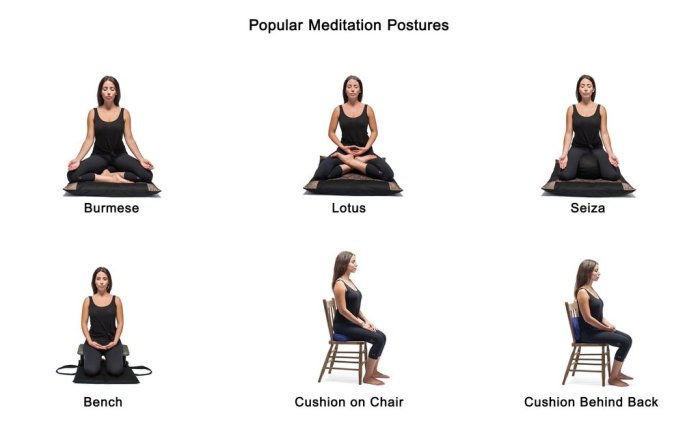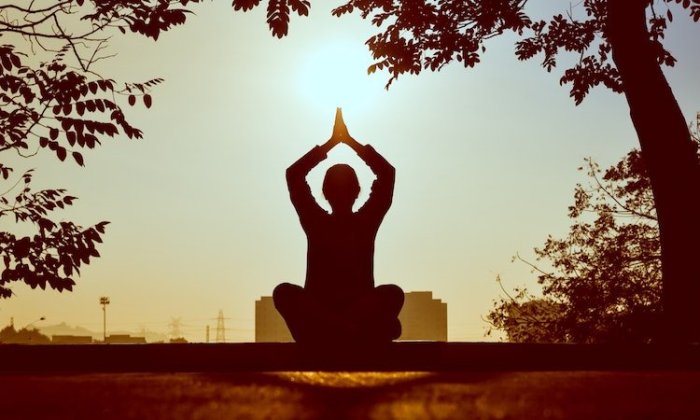Delving into 6 Meditation Styles to Explore, this introduction immerses readers in a unique and compelling narrative. Discover the transformative benefits of various meditation practices, from mindfulness to guided visualization, in a journey towards inner peace and self-discovery.
Explore the depths of each meditation style and uncover a path to holistic well-being through the art of meditation.
Introduction to 6 Meditation Styles

Meditation is a practice that involves training the mind to focus and redirect thoughts. It is often used to promote relaxation, reduce stress, and enhance personal growth. There are various meditation styles that offer unique techniques and approaches to achieve mental clarity and inner peace.
Exploring different meditation styles is important because it allows individuals to find the method that resonates most with them. Each style has its own benefits and can cater to different preferences and needs. By trying out various styles, practitioners can broaden their meditation experience and discover what works best for them.
The Benefits of Incorporating Various Styles into a Meditation Practice
- Improved Focus and Concentration: Different meditation styles can help enhance focus and concentration by training the mind to stay present in the moment.
- Stress Reduction: Exploring various meditation styles can provide practitioners with a range of tools to manage stress and promote relaxation.
- Enhanced Emotional Well-being: Different styles of meditation can help individuals cultivate a sense of inner peace, emotional balance, and overall well-being.
- Spiritual Growth: By incorporating different meditation styles, individuals can deepen their spiritual practice and explore different aspects of their inner selves.
- Increased Mindfulness: Practicing various meditation styles can improve mindfulness, awareness, and the ability to respond mindfully to life’s challenges.
- Personal Growth: Exploring different meditation styles can lead to personal growth, self-discovery, and a deeper understanding of oneself.
Mindfulness Meditation: 6 Meditation Styles To Explore

Mindfulness meditation is a practice that involves focusing on the present moment without judgment. It encourages individuals to observe their thoughts, emotions, and sensations as they arise, fostering a sense of awareness and acceptance.Originating from ancient Buddhist traditions, mindfulness meditation has been adapted and popularized in Western cultures as a way to reduce stress, increase self-awareness, and improve overall well-being.
Mindfulness Meditation Techniques
- Body Scan: This technique involves focusing on different parts of the body, starting from the toes and moving up to the head, to bring awareness to physical sensations.
- Breath Awareness: Practitioners concentrate on the breath, observing its natural rhythm and flow as a way to anchor themselves in the present moment.
- Walking Meditation: Walking slowly and deliberately, paying attention to each step taken and the sensations felt in the body while moving.
- Loving-Kindness Meditation: This practice involves sending wishes of compassion and love to oneself, loved ones, and even to difficult individuals, cultivating feelings of kindness and empathy.
Transcendental Meditation
Transcendental Meditation (TM) is a form of silent mantra meditation that was developed by Maharishi Mahesh Yogi in the 1950s. It involves sitting with closed eyes and silently repeating a mantra, which is a specific word or sound, in order to achieve a state of relaxed awareness.
Principles behind Transcendental Meditation
- Mantra Repetition: The practice involves the repetition of a specific mantra, which is believed to help the mind settle and reach a state of deep relaxation.
- Effortless Practice: TM is known for its emphasis on effortlessness, allowing thoughts to come and go without actively trying to control them.
- Transcending: The goal of TM is to transcend ordinary thinking and experience a state of pure awareness or transcendental consciousness.
Potential Benefits of Practicing Transcendental Meditation
- Stress Reduction: TM has been shown to reduce stress and anxiety levels, promoting a sense of calm and well-being.
- Improved Focus: Regular practice of TM can enhance concentration and mental clarity.
- Enhanced Creativity: Some practitioners believe that TM can unlock creativity and problem-solving abilities.
- Health Benefits: Research suggests that TM may have positive effects on cardiovascular health, immune function, and overall well-being.
Loving-Kindness Meditation
Loving-Kindness Meditation, also known as Metta Bhavana, is a meditation practice that focuses on cultivating feelings of love, compassion, and kindness towards oneself and others. It involves sending well-wishes and positive intentions to all beings, regardless of their relationship to you. This practice aims to increase feelings of love and compassion, reduce negative emotions, and promote overall well-being.
Effects of Loving-Kindness Meditation on Mental Well-Being
Loving-Kindness Meditation has been shown to have several positive effects on mental well-being. Research suggests that regular practice of this meditation technique can lead to increased levels of positive emotions, such as love, joy, and gratitude. It can also reduce symptoms of depression, anxiety, and stress. Additionally, Loving-Kindness Meditation helps in improving empathy, compassion, and social connections with others.
- Enhances positive emotions such as love, compassion, and gratitude.
- Reduces symptoms of depression, anxiety, and stress.
- Improves empathy, compassion, and social connections with others.
Steps to Practice Loving-Kindness Meditation
To practice Loving-Kindness Meditation, follow these simple steps:
- Find a quiet and comfortable place to sit or lie down.
- Close your eyes and take a few deep breaths to relax your body and mind.
- Start by sending loving-kindness to yourself by repeating phrases like “May I be happy, may I be healthy, may I be safe, may I live with ease.”
- Extend these well-wishes to loved ones, acquaintances, neutral individuals, difficult people, and eventually to all beings.
- Stay focused on each individual or group as you send them loving-kindness, and notice any emotions or sensations that arise.
- End the practice by bringing your awareness back to yourself and feeling gratitude for the ability to send love and kindness to others.
Yoga Meditation

Yoga and meditation have a deeply intertwined relationship, as both practices aim to cultivate inner peace, focus, and mindfulness. Yoga is not just about physical postures (asanas) but also includes breath control (pranayama) and meditation techniques. The combination of yoga and meditation can offer a holistic approach to health and well-being, benefiting both the body and the mind.
Types of Yoga Meditation Practices
- Hatha Yoga Meditation: Focuses on the practice of physical postures and incorporates breathing exercises and meditation to achieve a balance between body and mind.
- Kundalini Yoga Meditation: A spiritual practice that aims to awaken the dormant energy at the base of the spine through a combination of physical postures, breathing techniques, chanting, and meditation.
- Vinyasa Yoga Meditation: A dynamic form of yoga that synchronizes movement with breath, often incorporating meditation and mindfulness to create a flowing practice.
- Restorative Yoga Meditation: A gentle and relaxing form of yoga that uses props to support the body in passive poses, allowing for deep relaxation and meditation.
Physical and Mental Benefits of Yoga Meditation
- Improved Flexibility: Yoga postures combined with meditation can help increase flexibility and mobility in the body.
- Stress Reduction: The practice of yoga meditation can help reduce stress levels and promote relaxation through deep breathing and mindfulness.
- Mental Clarity: Yoga meditation techniques can enhance mental focus, concentration, and clarity of mind.
- Emotional Well-being: By incorporating meditation into yoga practice, individuals can cultivate a sense of inner peace, compassion, and emotional balance.
Guided Visualization Meditation

Guided visualization meditation is a practice where a meditation guide verbally leads participants through a series of images, scenes, or scenarios to achieve a state of deep relaxation and focus. This form of meditation harnesses the power of the mind’s eye to create a vivid mental picture that can help reduce stress, increase self-awareness, and promote overall well-being.
Role of Visualization in Guided Visualization Meditation, 6 Meditation Styles to Explore
Visualization plays a crucial role in guided visualization meditation by allowing individuals to create a mental image of a peaceful and calming place or situation. By visualizing specific scenes or scenarios, practitioners can engage their senses and emotions, making the experience more immersive and impactful. This process can help in reducing anxiety, improving concentration, and enhancing creativity.Examples of Guided Visualization Techniques:
- Beach Visualization: Imagine yourself lying on a beach, feeling the warm sun on your skin, hearing the sound of the waves, and smelling the salty sea breeze. This technique can help promote relaxation and a sense of tranquility.
- Forest Walk Visualization: Picture yourself walking through a serene forest, surrounded by tall trees, chirping birds, and a gentle breeze. This visualization can aid in grounding yourself and connecting with nature.
- Mountain Meditation: Visualize yourself climbing a majestic mountain, feeling a sense of accomplishment with each step you take. This technique can foster a sense of resilience and inner strength.
Final Wrap-Up

Embark on a journey of self-exploration and mental rejuvenation by embracing the diverse world of meditation styles. Cultivate mindfulness, transcend boundaries, and radiate loving-kindness as you embark on a transformative meditation practice.